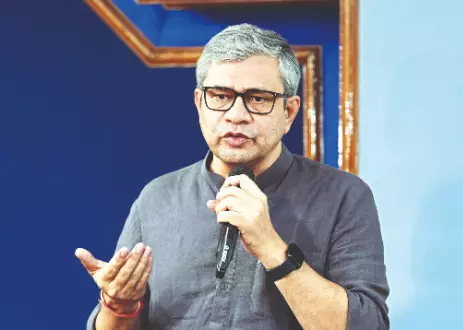ISM 2.0 to cover semicon ecosystem partners as well: Ashwini Vaishnaw

New Delhi: The second version of India Semiconductor Mission 2.0 will provide support not just for chip manufacturing projects but also to the ecosystem partners who play key roles in their production, Union Minister of Electronics and IT Ashwini Vaishnaw said on Tuesday.
While speaking to the media at Semicon India 2025, Vaishnaw said that a significant portion of the incentives will be earmarked for product development.
“Getting ecosystem partners into the country is very important because that is the way to sustainably grow.
“All the sectors need to be covered. We will continue that same approach and will give a lot of support to equipment manufacturers, material manufacturers and all other ecosystem partners. That will be a significant part of our journey,” the minister said in response to a question on the next version of the India Semicon Programme.
Under the first edition of India Semiconductor Mission, the government had approved an incentive of Rs 76,000 crore, comprising Rs 65,000 crore in incentives for chip production, Rs 10,000 crore for the modernisation of the Semiconductor Laboratory in Mohali and Rs 1,000 crore for the design-linked incentive scheme.
“We should get all the sectors covered from automotive to power electronics to consumer electronics to medical to defence and strategy. A very significant part of the allocation in the next version will also be for products. Developing full products means, as in chipsets which are designed here, the IP rights reside in our country,” Vaishnaw said.
Earlier in the day, Prime Minister Narendra Modi said 10 semiconductor projects worth over $18 billion are underway, and the country is advancing towards the next phase of the India Semiconductor Mission, and revamping the design-linked incentive scheme to tap the $1 trillion global chip market.
The work is underway on the next phase of the India Semiconductor Mission. The Prime Minister also said, “The government is going to give shape to the new DLI (design-linked incentive) scheme”.
Vaishnaw said the design projects under the schemes have progressed very well.
“We have provided the latest EDA (Electronic Design Automation) tools to 278 universities. By now, 60,000 engineering students have already worked on these EDA tools for more than 13 million hours. And these 17 student teams, who have designed these chips and taped them out, these chips were today presented to the Prime Minister,” the minister.
The chip presented to the Prime Minister also includes the first commercial-grade chip made by CG Semi.
Speaking at the Semicon India event, Electronics and IT Secretary S Krishnan said that critical semiconductor production projects may continue to get up to 70 per cent of the total project cost as an incentive from the Centre and states.
He said the government is looking to expand benefits under the design-linked incentive (DLI) to support larger domestic companies and enhance grants provided under it.
Krishnan said the support that India provides for semiconductor projects is unprecedented, and a total of around $30 billion in incentives and various other benefits is under implementation.
The central government has been providing 50 per cent capital support, while the state government gives incentives of around 20 per cent of the total project cost.



